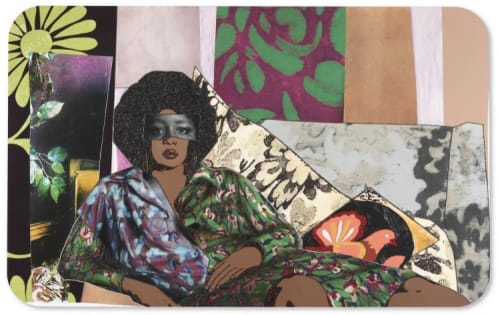First impressions of Mickalene Thomas’ paintings: They’re big, sexy and sensual female portraits with a whole lot of bling.
But the artist’s subjects and the many materials she incorporates to capture them — paint, photographs, fabric, textured paper and thousands of rhinestones — are starting points.
Thomas presents herself, her mother, her lovers and other women she admires in striking portraits that reveal intense communication between Thomas and her subjects — and social and cultural commentary to her audience.
The intriguingly titled “I Can’t See You Without Me” consists of 30-plus works by the Brooklyn-based artist. The exhibit continues through Dec. 30 at Ohio State University’s Wexner Center for the Arts. Each of the center’s galleries is devoted to one of Thomas’ muses or Thomas herself.
“Art is personal, and it should be,” Thomas. 47, said recently during a walk through the exhibit. “It’s the authentic place to work from.”
The subject of the first gallery is the artist’s late mother, Sandra — or “Mama Bush,” as she was known in the New Jersey neighborhood where Thomas grew up.
“Portrait of Madame Mamma Bush #2,” measuring 7 feet by 9 feet, is typical of the bold size and flamboyant use of color in the artist’s works. The woman reclines on a flowered sofa, staring at the viewer, supporting her head on one hand, her breasts exposed and one of her long legs folded under the other.
The portrait was created with acrylic and enamel paint on wood along with the many colored rhinestones that make all of Thomas’ portraits glittery and distinctive.
(Thomas said she loves “everything” about rhinestones: “They are decorative; they exude light. I don’t use them any differently than I use paint.”)
In each gallery, Thomas also has re-created living spaces, including the living room where she grew up in the 1980s that accompanies her mother’s portraits. This tableau includes a flowered couch, an end table and a lamp, books by Toni Morrison and Ralph Ellison, a pair of black patent-leather shoes on a rug, and a record player with big speakers playing Donna Summer music.
Another gallery is devoted to the sensual and confrontational portraits of Maya, a former lover of the artist. In these seductive nudes and seminudes, Maya emerges as a 1970s sex symbol — bold and defiant, never kittenish.
Thomas’ current partner, art collector and curator Racquel Chevremont, is the subject in another gallery, which contains the recently completed “Racquel: I See You” and, from 2015, “Racquel Reclining Wearing Purple Jumpsuit.” In each, the woman reclines on a couch, face raised upward and one leg held in the air. Both works demonstrate Thomas’ prowess in blending a variety of collage materials into a cohesive, painterly whole.
Michael Goodson, co-curator of the exhibit, said Thomas “has the ability to take these picture planes and just harness them.”
The exhibit also presents four of Thomas’ video works — including the newest, an erotic, multi-channel piece set to music by drummer and composer Terri Lyne Carrington.
Through her works, Thomas has redefined the African-American female. In speaking with Wexner Center officials, she said that the pop-culture image of many black women, presented largely as objects of desire, conflicts with her perspective.
“It was crucial for me to flip these ideas by making images of women who were not, for example, a ‘Foxy Brown’ but also weren’t in line with the marginalizing narrative of female subjects in Western art history.”
Although she might pose her nude or seminude subjects like those in famous Western artworks by Manet, Matisse, Ingres and others, Thomas’ women have their own presence — sexy, contemplative, defiant, seductive, proud or all of these combined.
As she walked through the exhibit, Thomas remarked on her “deep collaboration with my sitters,” adding, “I hope you get a great sense of the different women in their different spaces.”

